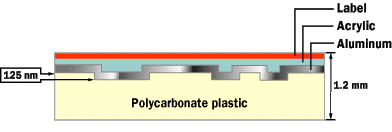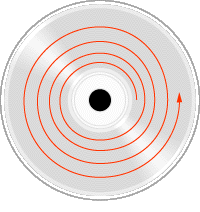Understanding the CD
As discussed in How Analog and Digital Recording Works , a CD can store up to 74 minutes of music, so the total amount of digital data that must be stored on a CD is:
44,100 samples/channel/second x 2 bytes/sample x 2 channels x 74 minutes x 60 seconds/minute = 783,216,000 bytes
To fit more than 783 megabytes (MB) onto a disc only 4.8 inches (12 cm) in diameter requires that the individual bytes be very small. By examining the physical construction of a CD, you can begin to understand just how small these bytes are.
A CD is a fairly simple piece of plastic, about four one-hundredths (4/100) of an inch (1.2 mm) thick. Most of a CD consists of an injection-molded piece of clear polycarbonate plastic . During manufacturing, this plastic is impressed with microscopic bumps arranged as a single, continuous, extremely long spiral track of data. We'll return to the bumps in a moment. Once the clear piece of polycarbonate is formed, a thin, reflective aluminum layer is sputtered onto the disc, covering the bumps. Then a thin acrylic layer is sprayed over the aluminum to protect it. The label is then printed onto the acrylic. A cross section of a complete CD (not to scale) looks like this:
 Cross-section of a CD |
What the picture on the right does not even begin to impress upon you is how incredibly small the data track is -- it is approximately 0.5 microns wide, with 1.6 microns separating one track from the next. (A micron is a millionth of a meter.) And the elongated bumps that make up the track are each 0.5 microns wide, a minimum of 0.83 microns long and 125 nanometers high. (A nanometer is a billionth of a meter.) Looking through the polycarbonate layer at the bumps, they look something like this: |
 |
You will often read about "pits" on a CD instead of bumps. They appear as pits on the aluminum side, but on the side the laser reads from, they are bumps.
The incredibly small dimensions of the bumps make the spiral track on a CD extremely long. If you could lift the data track off a CD and stretch it out into a straight line, it would be 0.5 microns wide and almost 3.5 miles (5 km) long!
To read something this small you need an incredibly precise disc-reading mechanism. Let's take a look at that.
Back to How It Works
› Introduction to How CDs Work
› Understanding the CD
› CD Player
› Data Formats
